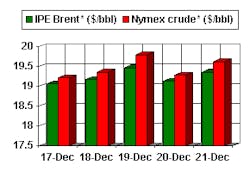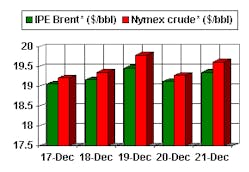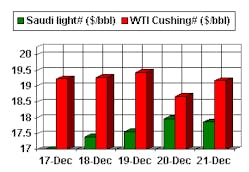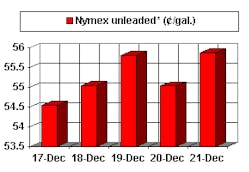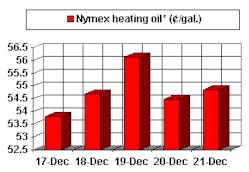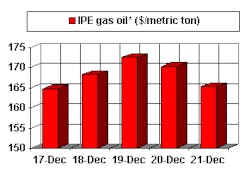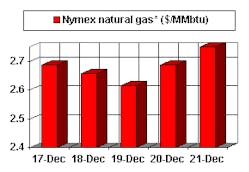This is the first of a two-part outlook for oil prices in 2002. Next week's column, containing the second part of this series, will appear without the usual accompanying price charts, due to author unavailability.
Has there ever been greater uncertainty for the direction of oil prices?
The oil industry at the outset of 2002 stands poised on a dual precipice: an oil price spike or collapse. Either or both could happen in the coming year.
At this writing, the Organization of Petroleum Exporting Countries and chief non-OPEC oil exporters were establishing an uneasy rapprochement over the scope of oil production cuts needed to right the market again. It seemed likely that enough non-OPEC cuts would be forthcoming to trigger the 1.5 million in cuts OPEC pledged to undertake at Cairo Dec. 28 on condition the non-OPEC nations would meet a threshold cut of 500,000 b/d. Whether that rapprochement survives the turn of the year was idle speculation at this writing. Whether this new OPEC confrontation with non-OPEC exporters dissipates or worsens, however, will determine the extent of downward pressure on oil prices this year and perhaps for years to come.
At the same time, the US-led coalition against terrorism was tightening the noose on Osama bin Laden and the Taliban in Afghanistan, and Washington, DC, was already sounding an early drumbeat for the next stage of the campaign: Iraq.
Whether an Iraqi oil supply disruption is in the cards will determine the extent of upward pressure on oil prices this year. Whether there is a domino effect involving other key exporters affected by civil unrest over the antiterrorism campaign or by the Israeli-Palestinian conflict could also determine the outlook for oil prices for years to come.
Post-Sept. 11
This dizzying dual scenario has its roots in the Sept. 11 terrorist attacks on the US.
The relationship of the antiterrorism campaign targeting Iraq and the events of Sept. 11 speaks for itself. But the OPEC vs. non-OPEC standoff warrants explanation.
The remarkable cohesion of OPEC in ratcheting oil supply up or down to fine-tune oil prices to within a desired range of $22-28/bbl (for a basket of OPEC crudes) had yielded the strongest oil price environment since the early 1980s. West Texas Intermediate crude oil was $26.69-31.95/bbl on an average quarterly basis from first quarter 2000 through third quarter 2001, noted Cambridge Energy Research Associates, Cambridge, Mass. That was the highest average price range for such a long span since 1985, and it came from a recent historic low: The price of Arab light crude had rocketed 117% to 2000 from $12.30/bbl in 1998.
OPEC's success faltered with a slowing economy in third quarter 2001. The group was mulling yet another price-bolstering production quota accord when the Sept. 11 attacks sent a slumping market into full collapse. Sensitivity to a post-Sept. 11 reaction to another engineered boost in oil prices led OPEC to defer further action on output cuts.
OPEC, non-OPEC standoff
It was the downward spiral of oil prices after OPEC's deferral of action that led the group to begin considering the loss of market share to non-OPEC exporters as having evolved from irritant into threat. (The irony here is that it was a non-OPEC exporter, Mexico, that helped Saudi Arabia and Venezuela overcome their feud 3 years ago and pave the way for OPEC's future cohesion.)
OPEC's gauntlet-tossing on the conditional non-OPEC cuts squarely targeted Russia, and with good reason. Russia has accounted for over half of non-OPEC production growth the past few years, with net oil exports projected to climb by as much as 1 million b/d this year from levels seen 5 years ago, according to Eugene Khartukov, general director of the Moscow-based International Center for Petroleum Business Studies. Khartukov forecast Russian oil production at 7.2-7.3 million b/d and exports at 3.4-3.5 million b/d in 2002. In 1997, those levels were 6.17 million b/d and 2.39 million b/d, respectively, Khartukov estimated.
Markets have taken a hopeful sign in the sight of Moscow relenting from its initial opposition to cooperating with OPEC on output cuts. But how substantive are those cuts? Frederick Leuffer, an analyst with investment banker Bear Stearns, remains skeptical that the pledged non-OPEC cuts will materialize.
The Russian offer of a cut in exports might seem a bit disingenuous in Leuffer's view. He notes in a recent research note that Russian oil exports typically decline in winter because of higher seasonal demand and weather-related infrastructure problems in the former Soviet Union: "Russia is unlikely to reduce oil production for several reasons having to do with production costs that are well below the current oil price; sunk costs to bring on higher volumes; distrust for OPEC, which has not been compliant with its own production quotas; and Russia's own history of not cooperating with OPEC."
Leuffer contends that the only way for OPEC to regain oil market share is for it to allow oil prices to fall to the mid-teens or lower.
"OPEC may be using Russia as a scapegoat to create a reason to lower oil prices," Leuffer said in the Dec. 6 note. "While we believe oil prices are in middle ground and the near-term outlook for prices is difficult to call, we believe oil prices are likely to retreat further over the next 3-6 months."
Calgary-based Canadian Energy Research Institute paints a similar picture, focusing on Saudi Arabia serving as engineer of another price war, as it did in 1985-86. But CERI, which forecasts WTI at an average $18.50/bbl in 2002, contends the new market share war may not be as short-lived as those in 1985-86 and 1998-99: "Low prices and high production levels are in Saudi Arabia's interests. Relatively high prices over the past few years could provide it with the relatively smooth transition it needs to move to a more sustained low-price strategy."
But this view runs counter to the evidence that Saudi Arabia was one of the principal architects of the price-band strategy and to the widely held perception that the kingdom would not let oil prices fall far enough to force it drain its cash reserves rather than cut budgets.
Then there is the economic fallout on Russia itself. Merrill Lynch, in a late November research note, foresaw Russian producers' resolve crumbling under government pressure. It noted that the oil and gas industry accounts for half of Russia's export and tax revenues; a $1/bbl change in oil prices has an effect of $1.5 billion on the Russian budget.
As the year came to a close, the likelihood grew that OPEC would undertake its cuts of 1.5 million b/d in line with non-OPEC pledges that fell less than 50,000 b/d short of the sought-for 500,000 b/d in cuts. Given the state of the market, that won't rally prices sharply; it will simply prevent a collapse and set the stage for oil prices to trade at the lower end of the OPEC target price band for much of the year.
But the market persists to exhibit a split personality. There remain strong price pressures both upward and downward. While OPEC may have dodged a bullet on the downside for now, the specter of increased competition from other supply sources still looms on the horizon. At the same time, the threat of supply disruption has grown since Sept. 11, and no one can predict when it will again diminish.
Next week's column will deal with the propspect of this duality continuing in the long term.
OGJ Hotline Market Pulse
Latest Prices as of Dec. 26, 2001
NOTE: PRICE CHARTS WILL NOT APPEAR WITH THE NEXT COLUMN, SCHEDULED TO RUN JAN. 4, DUE TO AUTHOR UNAVAILABILITY.
null
Nymex unleaded
null
Nymex heating oil
null
IPE Gas oil
null
Nymex natural gas
null
NOTE: Because of holidays, lack of data availability, or rescheduling of chart publication, prices shown may not always reflect the immediate preceding 5 days.
*Futures price, next month delivery. #Spot price.
